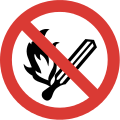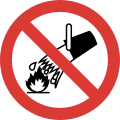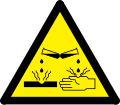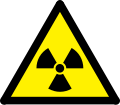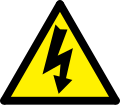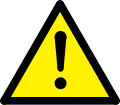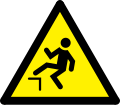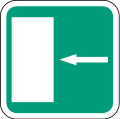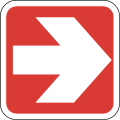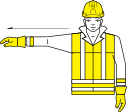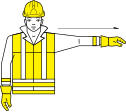
ISO 3864 specifies international standards for safety signs and markings in workplaces and public facilities. These labels are graphical, to overcome language barriers. The standard is split into four parts.

Traffic signs or road signs are signs erected at the side of or above roads to give instructions or provide information to road users. The earliest signs were simple wooden or stone milestones. Later, signs with directional arms were introduced, for example the fingerposts in the United Kingdom and their wooden counterparts in Saxony.

The general prohibition sign, also known informally as the no symbol, 'do not' sign, circle-backslash symbol, nay, interdictory circle, prohibited symbol, don't do it symbol, or universal no, is a red circle with a 45-degree diagonal line inside the circle from upper-left to lower-right. It is typically overlaid on a pictogram to warn that an activity is not permitted, or has accompanying text to describe what is prohibited.

A crash bar is a type of door opening mechanism which allows users to open a door by pushing a bar. While originally conceived as a way to prevent crowd crushing in an emergency, crash bars are now used as the primary door opening mechanism in many commercial buildings.

An emergency exit in a building or other structure is a special exit used during emergencies such as fires. The combined use of regular and emergency exits allows for faster evacuation, and emergency exits provide alternative means of evacuation if regular exits are inaccessible.
Electrical wiring in the United Kingdom is commonly understood to be an electrical installation for operation by end users within domestic, commercial, industrial, and other buildings, and also in special installations and locations, such as marinas or caravan parks. It does not normally cover the transmission or distribution of electricity to them.

Dangerous goods, abbreviated DG, are substances that when transported are a risk to health, safety, property or the environment. Certain dangerous goods that pose risks even when not being transported are known as hazardous materials. An example for dangerous goods is hazardous waste which is waste that has substantial or potential threats to public health or the environment.

Road signs in the United Kingdom and in its associated Crown dependencies and overseas territories conform broadly to European design norms, though a number of signs are unique: direction signs omit European route numbers and road signs generally use the Imperial System of units, unlike the rest of Europe. Signs in Wales and parts of Scotland are bilingual.
A placard is a notice installed in a public place, like a small card, sign, or plaque. It can be attached to or hung from a vehicle or building to indicate information about the vehicle operator or contents of a vehicle or building. It can also refer to paperboard signs or notice carried by picketers or demonstrators.
Building regulations in the United Kingdom are statutory instruments or statutory regulations that seek to ensure that the policies set out in the relevant legislation are carried out. Building regulations approval is required for most building work in the UK. Building regulations that apply across England and Wales are set out in the Building Act 1984 while those that apply across Scotland are set out in the Building (Scotland) Act 2003. The Act in England and Wales permits detailed regulations to be made by the Secretary of State. The regulations made under the Act have been periodically updated, rewritten or consolidated, with the latest and current version being the Building Regulations 2010. The UK Government is responsible for the relevant legislation and administration in England, the Welsh Government is the responsible body in Wales, the Scottish Government is responsible for the issue in Scotland, and the Northern Ireland Executive has responsibility within its jurisdiction. There are very similar Building Regulations in the Republic of Ireland. The Building Regulations 2010 have recently been updated by the Building Safety Act 2022.

The Traffic Signs Regulations and General Directions is the law that sets out the design and conditions of use of official traffic signs that can be lawfully placed on or near roads in Great Britain and the Isle of Man. The regulations, originally introduced in 1965, were the result of the review of British road signage carried out by the Worboys Committee.

Office space planning is the process of organizing the workplace layout, furniture and office functions to work effectively together, while using space efficiently. Floor plans should consider the workgroup function, building codes and regulations, lighting, teaming requirements, inter-communication and storage, as well as zoning for employee workstations, task space needs, support rooms and reception areas to make the best use of available space. Optimising office spaces with effective space planning can aid circulation, productivity and improve workplace wellness, as well as the health and safety of occupants.

Barricade tape is brightly colored tape that is used to warn or catch the attention of passersby of an area or situation containing a possible hazard. It acts as a minor impediment to prevent accidental entrance to that area or situation and as a result enhances general safety. Barricade tape is also known as construction tape or barrier tape, or in reference to the safety hazard involved as caution tape, warning tape, danger tape or hazard tape. When used by police, the tape is named police tape.
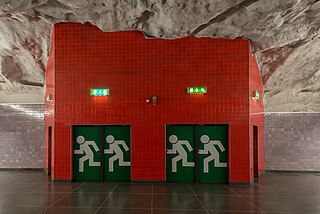
An exit sign is a pictogram or short text in a public facility denoting the location of the closest emergency exit to be used in case of fire or other emergency that requires rapid evacuation. Most relevant codes require exit signs to be permanently lit at all times.
Pipe marking is the used to identify the contents, properties and flow direction of fluids in piping. Marking assists personnel to identify the correct pipes for operational, maintenance or emergency response purposes. Pipes are marked by labels, typically color coded, to identify the use, contents and flow direction.

ISO 7010 is an International Organization for Standardization technical standard for graphical hazard symbols on hazard and safety signs, including those indicating emergency exits. It uses colours and principles set out in ISO 3864 for these symbols, and is intended to provide "safety information that relies as little as possible on the use of words to achieve understanding."

Safety signs are a type of sign designed to warn of hazards, indicate mandatory actions or required use of Personal protective equipment, prohibit actions or objects, identify the location of firefighting or safety equipment, or marking of exit routes.
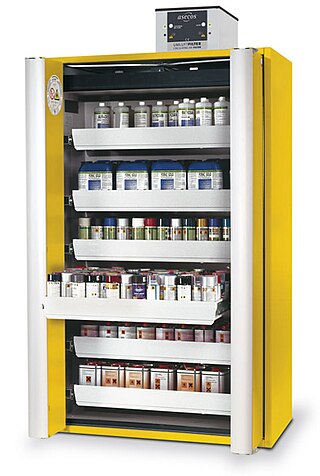
A safety cabinet is used for the safe storage of flammable chemical substance or compressed gas cylinders.
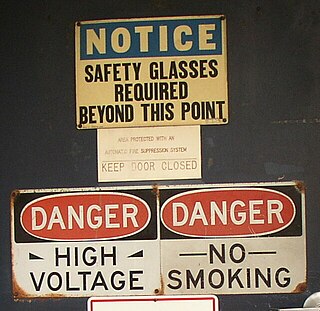
ANSI Z35.1 the Specifications for Accident Prevention Signs, was an American standard that dictated the layout, colors and wording of safety signs in the United States. The standard is the first American standard that made specific demands for the design, construction, and placement of safety signage in industrial environments. The first edition was published in January 1941, and the fourth and final edition in November 1972. Changes in societal needs of signage, and further research into signage would result in the establishment of a new committee, the ANSI Z535 Committee on Safety Signs and Colors, combining the separate committees of Z35.1 - Specifications for Accident Prevention Signs, Z35.2 - Specifications for Accident Prevention Tags, and Z53 - Marking Physical Hazards Safety Color Code, resulting in a new combined standard, ANSI Z535.

The Directive 92/58/EEC specifies the minimum requirements for safety signs within the European Union. It superseded the Directive 77/576/EEC. While not being replaced by the standard ISO 7010, both signage systems can be used. This directive does not apply to signage used for controlling roadway, railway, waterway or air transportation.













